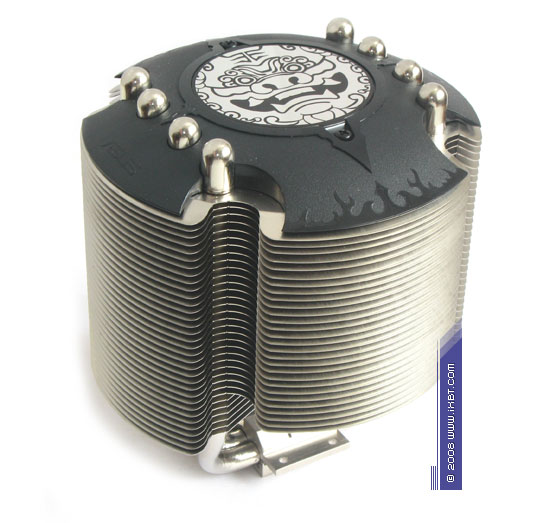We proceed with our reviews of advanced air cooling systems. Today we are going to examine two products from ASUS: Lion Square and Triton 85. Although both coolers have only recently appeared in our local market, they are already ranked high in company's model range. These coolers boast of original design and promising functionality. They also feature some interesting technical elements, which we are eager to examine.
So, first of all, let's examine design and usability of our today's products under review, and then we'll proceed to the highlight of our research -- practical test results of Lion Square and Triton 85 coolers.
Lion Square
Lion Square inherits the High-End class of its precedessor -- Silent Knight II. The image of this cooler definitely shows that its engineers tried to do everything perfect, no compromises. The cooler is really impressive -- Lion Square offers an advanced configuration formed by a copper heat sink (35x30x7 mm), four copper heat pipes (8 mm in diameter), aluminum finning (complex radial-tower structure, 125x90 mm), and an "integrated" fan (92x92x25 mm, 2300 rpm, PWM control).
The new cooler also has good thermal parameters -- the main highlight of Lion Square is its finning with artful, even symbiotic, configuration: it's based on the typical tower design, but the working medium is spiced up with semi-virtual separation into sections (in fact, there are two fin stacks connected with small radial bridges at fin edges, four heat pipes per section) and "central interface" position of the on-board fan (the fan is submerged to the finned "cradle").

Along with the reasonable configuration (34 fins in a stack (28 bridges), 0.3 mm thick, installed at 2.5-mm steps, total heat exchange surface area about 4500 cm2), this approach allows to assemble a very effective heatsink-fan system: dual-sided ventilation helps generate pronounced air flow both at the exhaust and intake of the impeller, and balanced fin parameters (bigger fin steps, shorter passages between fins) minimize hydraulic resistance of the heat sink, providing its normal operation even in case of weak air flows. That is Lion Square offers serious thermal potential and has all chances to compete with much bigger products, which are often based on the extensive factor (immense heat exchange surface area) instead of taking advantage of intensive heatsink design.

We should also note thicker heat pipes -- they are 8 mm in diameter instead of the popular 6-mm design. As a rule, thicker pipes (with the increased inner diameter and more developed capillary structure) cope better with their heat transfer functions and can make a weighty contribution to intensification of the heat exchange process, indirectly affecting the reduction of thermal resistance of the cooler. But sometimes things happen in a different scenario -- thick pipes are installed in wrong entourage (just for the sake of appearance, to diversify a marketing image of a cooler), and such "innovations" actually bring no noticeable improvements in thermophysical properties. Fortunately, Lion Square knows how to use thick heat pipes in a technically correct manner: they interact effectively with the heat sink (joints are adjusted for four pipes exactly, with expanded area of thermal contact) and fin stacks (the pipes are spaced apart from each other). All these aspects should definitely improve heat exchange processes in the working medium of the cooler.
We should also mention that Lion Square is equipped with a good fan (Sunon KDE1209PTVX), notable for a neat combination of aerodynamic and electromechanical characteristics. For example, the fan demonstrates perfect order in aerodynamic parameters of its impeller: wide crescent chord, moderately aggressive angles of attack, and tight work field (increased chord-step ratio) -- these parameters speak clearly for impeller configuration designed for increased performance and noise reduction. We have no gripes with the technical quality either -- the fan uses high-quality mechanic components (hydrodynamic bearing Vapo, special magnetic levitation MagLev) and neat electric fitting, which efficiently neutralizes structural side noises (the notorious electroacoustic effect, called engine whirring, is cardinally muffled in the noise spectrum of Lion Square).


What concerns usability, this product also tries to conform to the rules of good form, providing acceptable usability where possible. Indeed, Lion Square makes a big step forward here in comparison with Silent Knight II -- its installation procedures are very simple and user-friendly, be it Intel LGA775 or AMD Socket AM2. AMD Socket AM2 is the easiest platform to install Lion Square: the bundle includes a standard mounting bracket with a lever, the cooler is fixed directly in the socket frame, and the installation process is just as trivial as installing a usual boxed cooler.

The installation process is a bit trickier on the Intel LGA775 platform -- Lion Square comes with a mounting plate and two mounting brackets with spring-loaded screws. That is a motherboard must be removed from an enclosure prior to the installation. Besides, you'll have to use a screw driver. That's slightly disappointing. However, this cooler is very heavy (about 750 g), its screws ensure reliable and tight planting of the heat sink into the socket and provide optimized thermal contact, so we can only welcome this overhauled retention module of Lion Square.

Besides, this cooler offers PWM control for its on-board fan -- 4-pin fan headers have become widely spread, so it's a normal feature. The adjustment range is very wide here (fan speed varies from 500 rpm to 2300 rpm) -- so in case of low or medium thermal load on a processor, the on-board fan can guarantee almost noiseless operation of the fan and still preserve acceptable temperature conditions. If you pay close attention not only to purely technical aspects of coolers, but also to their modding components, you will certainly like local LED illumination -- four bright-blue LEDs supplied by ASUS engineers.
Write a comment below. No registration needed!







